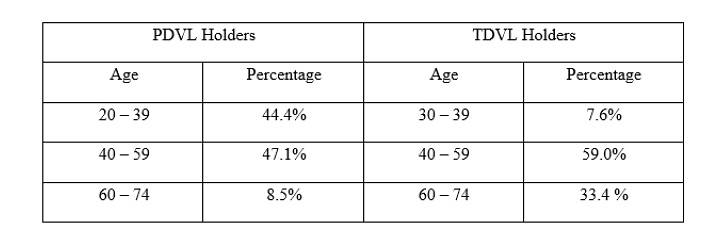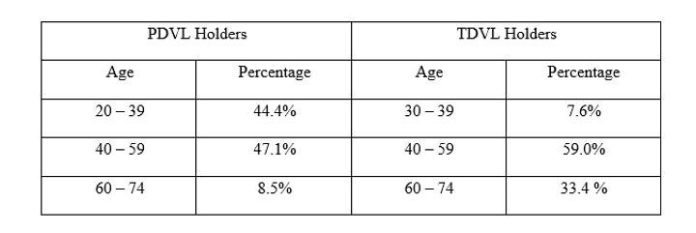SINGAPORE: For up to 10 hours daily for six days a week, Wendy Tan works as a private hire driver, whilst also studying part-time for her degree in tourism, events management and marketing at a private university.
The 24 year old is one of 41,000 Private Hire Car Driver’s Vocational Licence (PDVL) holders in Singapore, of which 44.4 per cent are aged between 20 and 39 years.
This is according to data revealed by the Ministry of Transport (MOT) during the recent Parliamentary sitting held in May.

Data from the Ministry of Transport, May 2019
Ms Tan who has been a private hire driver for the last three years, told CNA that she decided to drive to pay for her study loan. She added that her monthly take-home salary is between S$3,000 and S$5,000.
She begins each work day at 6am and attends half-day classes once every two weeks.
“I like the flexibility (of being a private hire driver), as it fits my schedule and helps me financially to pay the bills,” said Ms Tan. “Unlike other jobs, you answer to yourself only and you don’t get scolded for not turning up.”
“You really don’t learn anything new and there are physical risks to the job. You don’t know when you will get into an accident and five out of 10 drivers out there are reckless,” she added.
24 year old Ms Wendy Tan has been a private hire driver for the last three years to pay for her private university study loans. (Photo: Aaron Chong)
When asked how many drivers it has on its register that are aged between 20 and 39 years old, Grab said it was not able to provide the figure. However, the company said its data showed that “the vast majority of younger drivers are part-time or casual drivers”.
Grab added that the company attracts drivers “because (it) prioritises their welfare and continue to meet their needs in various ways”.
“For instance, we help with their operating costs and expenses through our comprehensive driver-partners welfare programme which offers fuel and car maintenance discounts, Medisave co-contribution, mobile phone plan discounts, bespoke insurance at affordable premiums and more.”
Meanwhile, fellow private car hire firm Go-Jek said it welcomes younger drivers into the ride-hailing sector, and adds that they form a “big part” of what it described as the “gig economy”.
Besides “competitive incentives”, the Indonesia-headquarted company also offers Prolonged Medical Leave insurance coverage, fuel rebates and mobile data savings to its drivers.
Dr Walter Theseira, transport economist at the Singapore University of Social Sciences (SUSS), attributed several factors to the significant proportion of young private hire drivers.
This includes technology platforms and incentive structures used by private car hire companies that “have more appeal” to younger workers.
Moreover, the private hire vehicles allow personal use of the vehicle, whereas taxis do not.
In addition, Dr Theseira noted that the take-home pay is “competitive” with many entry-level jobs for educated younger workers, after factoring in incentives and accounting for no CPF deductions.
“The image of taxi driving, unfortunately, is that it is a last resort job people turn to when they are retrenched and unable to restart their career. The image of private hire driving is that this is a side-income choice chosen for flexibility.
These social perceptions did not come about by accident. We have to remember that private hire companies have spent a lot of time, effort and money in marketing private hiring driving as an attractive side-income opportunity, to overcome the social perception that for-hire drivers are in a last resort job,” added Dr Theseira.
LACK OF OPPORTUNITIES IN THE PRIVATE SECTOR
It is 12 noon on a rainy Thursday and Shaun Ow has just had his lunch. For many professionals, it would be the mid-point of their working day. For Mr Ow, however, he is about to start the day’s work.
He places his mobile phone on the phone holder on top of his car’s dashboard and turns on the app operated by a well-known transportation network company, waiting for a pick-up order from his first passenger of the day.
The 39 year old said he has been a private hire car driver for the last 3.5 years and drives daily, between 12 and 14 hours a day. Prior to this, Mr Ow was working in the private sector for over 11 years in various industries but was retrenched.
He explained that he decided to be a full-time private hire car driver after trying for over a year to secure a job in the private sector, but to no avail.
Mr Ow shared that his monthly take-home pay after accounting for rental, fuel and other miscellaneous charges, is around S$5,000, after doing between 20 and 25 trips daily.
While he said the job scope “is very simple” and a matter of “bringing a person from where they are to where they want to go”, being a driver has its challenges.
“We don’t have one or two bosses that we report to like in the office, but if we do 20, 25 or 30 trips a day, those passengers are our bosses,” added Mr Ow.
“Passengers sometimes think our job is easy – sitting in an air-conditioned environment is easy. But I always tell them: ‘You find one weekend, have two one-hour breaks for lunch and dinner, and sit in a comfortable sofa for 12 hours just watching TV. You will feel sore backs, sore shoulders, sore necks, sore everywhere,” he said.
“We always have to be alert, vigilant (of) traffic. We can be very careful, but traffic is always moving with motorists, pedestrians and now with PMDs (personal mobility devices) – that is a lot of grief.”
POTENTIAL SOCIETAL ISSUE
While working as a driver offers certain advantages for individuals, Dr Theseira said that having a large number of young private hire drivers for the long-term raises some issues.
“The jobs offer no career path and do not provide workers with significant marketable skills. This means that workers in such jobs will inevitably end up disadvantaged compared to their peers who are able to stay in jobs that offer a career path and the opportunity to build marketable skills,” he added.
Dr Theseira said this is something that workers are not expected to recognise early on, similar to expecting 20 year olds not to save for their retirement. He felt that the latter group is “likely to under-appreciate the importance of building experience marketable skills as soon as possible”.
“Thus, if workers are attracted to private-hire driving and other ‘gig’ economy jobs and spend too long in them early on, their lifetime wages and career opportunities could be harmed significantly.”
WHAT CAN BE DONE
Dr Theseira said that it is more pertinent for Singapore to explore the wage and career structure of industries that employ medium-skilled young workers.
“What we should really think about is why many of the jobs that employ our NITEC and Poly Diploma holders pay comparably or worse than the earnings achievable by gig economy workers. This doesn’t make any economic sense because NITEC and Diploma holders actually have extensive training to perform a particular skilled job.
Institute of Technical Education (ITE) at Ang Mo Kio. (Photo: Jeremy Long)
“These are workers who have received two to three years of specialist training. Why does the market pay them the same or less than a gig economy platform does for a job that requires virtually no training whatsoever?” he added.
Dr Theseira also noted that many gig platforms operate at a loss, and are able to do so for extended periods due to venture capital financing. This is in contrast to conventional companies that are “constrained” by needing to record profits.
He further explained that as such, gig economy platforms “sell the service at below cost”, leading to wages “that are higher than they should be”.
“This has not been seen as a problem by Government, because effectively venture capital money is subsidising Singaporean workers, but it could be a problem if it results in workers disrupting their career paths.”
Meanwhile, Ms Tan and Mr Ow they said they will most likely continue being private hire drivers.
Although Ms Tan intends to find a job in the private sector, she acknowledged it will be difficult, as her vehicle lease contract which began in October 2018 has more than four years remaining.
In Mr Ow’s case, he said he has become comfortable with the job.
“To be frank, it is also (being) in a comfort zone. I am comfortable. I know how much effort I need to put in (to) get roughly how much (money). If I need more, I just drive more,” he said.





